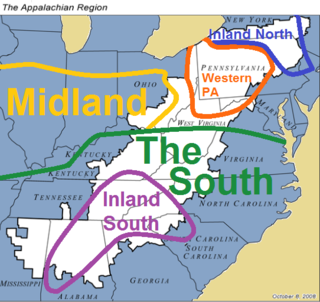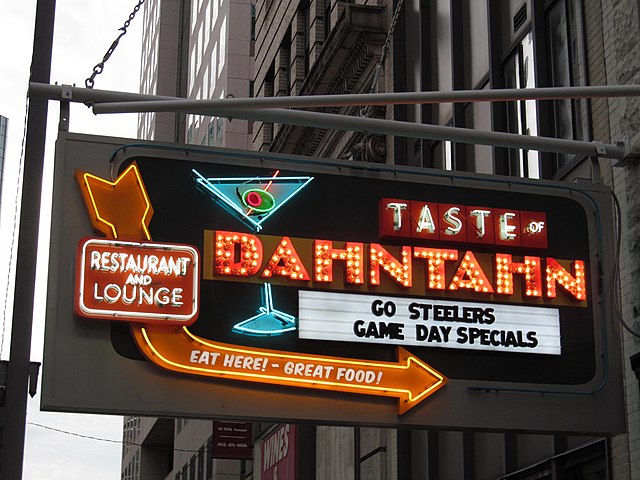Loading AI tools
Dialect of American English From Wikipedia, the free encyclopedia
Western Pennsylvania English, known more narrowly as Pittsburgh English or popularly as Pittsburghese, is a dialect of American English native primarily to the western half of Pennsylvania, centered on the city of Pittsburgh, but potentially appearing in some speakers as far north as Erie County, as far west as Youngstown, Ohio, and as far south as Clarksburg, West Virginia.[1][2] Commonly associated with the working class of Pittsburgh, users of the dialect are colloquially known as "Yinzers".
| Western Pennsylvania English | |
|---|---|
| Pittsburgh English, Pittsburghese | |
| Region | Western Pennsylvania |
Indo-European
| |
Early forms | |
| English alphabet | |
| Language codes | |
| ISO 639-3 | – |
| Glottolog | west2919 |
 Appalachia (in white) overlaid with dialect regions defined by the 2006 ANAE. Western Pennsylvania English can be seen in orange. | |

Scots-Irish, Pennsylvania Dutch, Polish,[3] Ukrainian[4] and Croatian[5] immigrants to the area all provided certain loanwords to the dialect (see "Vocabulary" below). Many of the sounds and words found in the dialect are popularly thought to be unique to Pittsburgh, but that is a misconception since the dialect resides throughout the greater part of western Pennsylvania and the surrounding areas.[6][7] Central Pennsylvania, currently an intersection of several dialect regions, was identified in 1949 by Hans Kurath as a subregion between western and eastern Pennsylvania,[8][9] but some scholars in the 20th century onwards have identified it within the western Pennsylvania dialect region.[9][10] Since Kurath's study, one of western Pennsylvania's defining features, the cot–caught merger, has expanded into central Pennsylvania,[11] moving eastward until being blocked at Harrisburg.[12] Perhaps the only feature whose distribution is restricted almost exclusively to the immediate vicinity of Pittsburgh is /aʊ/ monophthongization in which words such as house, down, found, and sauerkraut are sometimes pronounced with an "ah" sound, instead of the more standard pronunciation of "ow", rendering eye spellings such as hahs, dahn, fahnd, and sahrkraht.
Speakers of Pittsburgh English are sometimes called "Yinzers" in reference to their use of the second-person plural pronoun "yinz." The word "yinzer" is sometimes heard as pejorative, indicating a lack of sophistication, but the term is now used in a variety of ways.[13] Older men are more likely to use the accent than women "possibly because of a stronger interest in displaying local identity...."[14]
A defining feature of Western Pennsylvania English is the cot–caught merger, in which /ɑ/ (as in ah) and /ɔ/ (as in aw) merge to a rounded /ɒ/ (phonetically [ɒ~ɔ]). As in most other American dialects, the father–bother merger also occurs.[6][7][15] Therefore, cot and caught are both pronounced /kɒt/; Don and dawn are both /dɒn/. While the merger of the low back vowels is also widespread elsewhere in the United States, the rounded realizations of the merged vowel around [ɒ] is less common, except in Canada, California and Northeastern New England.[6][7]
/ɒ/ has a stylistic variant, which is open central unrounded [ä], as in the sarcastic pronunciation of I apologize as [aɪ əˈpʰäɫɨdʒaɪz]. It may also occur before /r/, as in start [stäɹʔt] or car [kʰäɹ], but a more common pronunciation is back and rounded: [stɒɹʔt] etc. The vowel in hoarse is the same as the one in horse, phonetically [ɔ]: [hɔɹs] but phonemically /oʊ/ due to the cot-caught merger: /hoʊrs/.[16][17]
/ʌ/ is backer and more open than [ɜ] found in Midland American English, being closer to [ɑ]. This makes STRUT an unrounded counterpart of LOT, with pairs such as nut [nɑʔt] vs. not [nɒʔt] or cut [kʰɑʔt] vs. cot [kʰɒʔt] contrasting mainly by roundedness. This is also found in contemporary Standard Southern British English, where nut [nʌʔt] also differs from not [nɔʔt] by rounding (though nought has a contrastive THOUGHT vowel instead: [no̞ːʔt], which falls together with [ɒ] in Pittsburgh). Earlier reports give [ɜ] as the norm for STRUT in Pittsburgh. The remaining checked vowels /ɪ/, /ʊ/, /ɛ/ and /æ/ are all within the General American norm.[18][19][20]
The GOAT vowel often has an unrounded central or fronted starting point in Pittsburgh: [əʊ]. Outside of the city itself, [oʊ] is more common. GOOSE is sometimes also fronted, to [ɨu] (more usual value: [ʊu]). As in other American dialects, FLEECE and FACE are narrow diphthongs [ɪi, ee̝]. CHOICE is also within GenAm norm: [ɔ̟ɪ].[21]
The PRICE vowel alone undergoes Canadian raising to [ɜɪ] before voiceless consonants, as in ice [ɜɪs]. In 1971, the Journal of the International Phonetic Association published a description of the dialect, whose author Bruce Lee Johnson notes that the auxiliary verb might is typically pronounced with nasalization, as [mɜ̃ɪ̃ʔt].[22] Elsewhere in the article, this allophone is transcribed ⟨ʌɪ⟩, following its usual transcription on Wikipedia.
The MOUTH vowel typically begins front in the mouth [æʊ]. A less common variant has a central starting point, [äʊ], matching the starting point of PRICE ([äɪ]).[16] It is monophthongized to [aː] in some environments (sounding instead like ah), namely: before nasal consonants (downtown [daːnˈtʰaːn] and found [faːnd]), liquid consonants (fowl, hour) and obstruents (house [haːs], out, cloudy).[6][7][15] The monophthongization does not occur, however, in word-final positions (how, now), and the diphthong then remains [æʊ].[23] That is one of the few features, if not the only one, restricted almost exclusively to western Pennsylvania in North America, but it can sometimes be found in other accents of the English-speaking world, such as Cockney and South African English.[6][7] The sound may be the result of contact from Slavic languages during the early 20th century.[7] Monophthongization also occurs for the sound /aɪ/, as in eye, before liquid consonants,[6][7][15][24] so that tile is pronounced [tʰɑːɫ]; pile is pronounced [pʰɑːɫ]; and iron is pronounced [ɑːɹn]. That phenomenon allows tire to merge with the sound of tar: [tʰɑːɹ].
The NURSE vowel (phonemically an /ər/ sequence) is phonetically close-mid [ɘ˞].[25]
Johnson notes a tendency to diphthongize /æ/ to [ɛə] not only before nasals (as in GenAm) but also before all voiced consonants (as in bad [bɛəd]) and voiceless fricatives (as in grass [ɡɹɛəs]).[25] This has since been reversed and now [ɛə] is confined to the environment of a following nasal, matching the GenAm allophony.[26]
An epenthetic (intruding) /r/ sound may occur after vowels in a few words, such as water pronounced as [ˈwɔɹɾɚ], and wash as [wɔɹʃ].[6][7]
A number of vowel mergers occur uniquely in Western Pennsylvania English before the consonant /l/. The pair of vowels /i/ and /ɪ/ may merge before the /l/ consonant,[6][7][15][27] cause both steel and still to be pronounced as something like [stɪɫ]. Similarly, /u/, /oʊ/, and /ʊ/ may merge before /l/, so that pool, pull, and pole may merge to something like [pʰʊɫ]. On the /il/~/ɪl/ merger, Labov, Ash and Boberg (2006) note "the stereotype of merger of /ɪl ~ il/ is based only on a close approximation of some forms, and does not represent the underlying norms of the dialect."[28] The /i/~/ɪ/ merger is found in western Pennsylvania,[6][7][15][27] as well as parts of the southern United States, including Alabama, Texas and the west (McElhinny 1999). On the other hand, the /u/~/ʊ/ merger is consistently found only in western Pennsylvania. The /i/~/ɪ/ merger towards [ɪ] may also appear before /ɡ/: eagle then sounds to outsiders like iggle.[6][7][15]
L-vocalization is also common in the Western Pennsylvania dialect; an /l/ then sounds like a /w/ or a cross between a vowel and a "dark" /l/ at the end of a syllable.[6][7][29] For example, well is pronounced as [wɛw]; milk as [mɪwk] or [mɛwk]; role as [ɹʊw]; and cold as [ˈkʰʊwd]. The phenomenon is also common in African-American English.
The word mirror can be pronounced as the single-syllable mere.[citation needed]
Western Pennsylvania English speakers may use falling intonation at the end of questions,[6][7][30] for example, in "Are you painting your garage?" [↗ˈɒɹ jə ˈpʰeɪɾ̃ɪŋ jɚ ɡə↘ˈɹɒdʒ] (with pitch rising in intonation up to just before the last syllable and then falling precipitously).[30] Such speakers typically use falling pitch for yes–no questions for which they already are quite sure of the answer. A speaker uttering the above example is simply confirming what is already thought: yes, the person spoken to is painting their garage. It is most common in areas of heavy German settlement, especially southeastern Pennsylvania,[30] hence its nickname, the "Pennsylvania Dutch question", but it is also found elsewhere in Pennsylvania, including Pittsburgh.[6][7][30][31][32][33][34] It is of German origin.[30]

Seamless Wikipedia browsing. On steroids.
Every time you click a link to Wikipedia, Wiktionary or Wikiquote in your browser's search results, it will show the modern Wikiwand interface.
Wikiwand extension is a five stars, simple, with minimum permission required to keep your browsing private, safe and transparent.